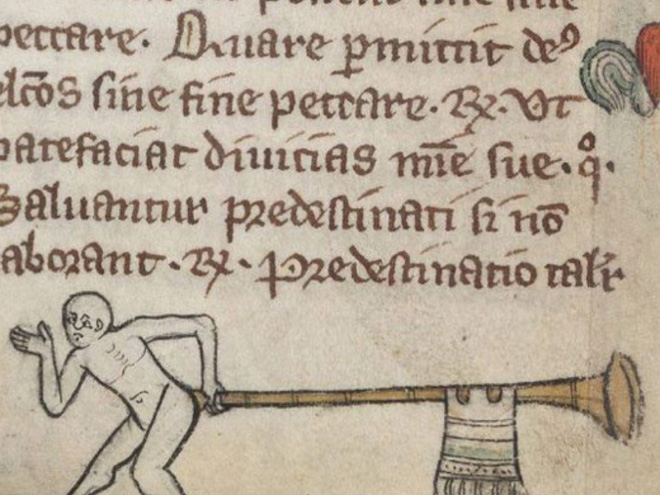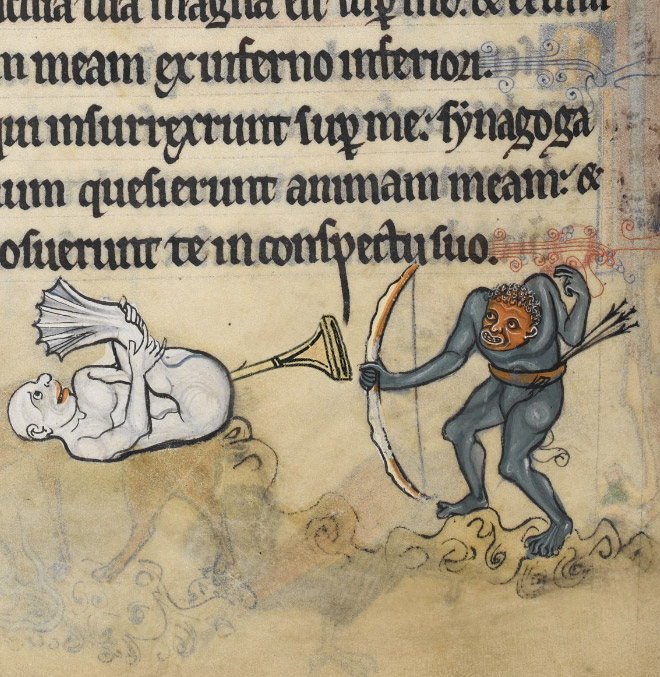In illuminated manuscripts, Medieval Europe can seem more like Monty Python and the Holy Grail than the grim tales of grey-faced, mildewed kings, monks, knights, and peasants turned out by the Hollywood dozen. Yes, life could be brutal, bloody, disease-ridden, but it could also be absurdist and unintentionally hilarious, qualities that reach their apex in the weirdness of Hieronymus Bosch’s “painful, horrible” musical instruments in his Garden of Earthly Delights.
While Bosch painted his nightmarish cacophonies, Medieval scribes’ cats peed and left inky footprints on 15th century manuscripts, within whose illustrated pages, rabbits play church organs, valiant knights do battle with giant snails, and a naked man blows a trumpet with his rear end (a precursor to the man in Bosch’s painting with a flute stuck in his rear.) “These bizarre images,” TED Ed notes, “painted with squirrel-hair brushes on vellum or parchment by monks, nuns, and urban craftspeople, populate the margins of the most prized books from the Middle Ages.”

The animated video lesson at the top by Michelle Brown “explores the rich history and tradition of illuminated manuscripts” in their eccentricity and seeming silliness. The animal motifs in marginal illustrations were neither aimless doodles nor inside jokes. They were allegorical figures descended from the menageries of Medieval bestiaries, repeated thematically to represent human vices and virtues. Rabbits, for example, represented lust, and their music-making was a virtuous sublimation of the same.
These associations weren’t always so clear, especially when they were explicitly religious. The porcupine picking fruit from its spine could represent either devil or savior, depending on context. The unicorn, which can only be killed with its head in the lap of a virgin, might stand for sexual temptation or the sacrifice of Christ. But the few readers in this manuscript culture would have recognized the references and allusions, although, like all signs, the illustrations communicate several different, even contradictory, meanings at once.

And what of the butt trumpet? It is “likely shorthand to express disapproval with, or add an ironic spin to, the action in the text.” The butt trumpet, ladies and gentlemen, is as advertised: that most venerable of expressions, the fart joke, to which there is no witty reply and which—as scatological humor can do—might be slyly subversive political critique. Literate or not, Medieval Europeans spoke a language of symbols that stood in for whole folk traditions and theologies. The butt trumpet, however, is just objectively, crudely funny, probably as much to the artists who drew them as to those of us, hundreds of years later, encountering them for the first time. See several more examples here and learn more about Medieval and Renaissance manuscripts here.
Related Content:
Why Knights Fought Snails in Illuminated Medieval Manuscripts
Josh Jones is a writer and musician based in Durham, NC. Follow him at @jdmagness


Just so you know. I made my living as a medieval musicologist (JAMS, 1978, p.1 et passim). The world is in trouble. We have a lunatic as President. The world listens to crazies instead of people with something to say. And what does a magazine on culture have to enlighten us about? Fart humor.
As a student of the deep occult, I would assure you that all things are just fine.
Lighten up Francis.
oh, thank God!
Am I to trust in you now?
You will Assisi .